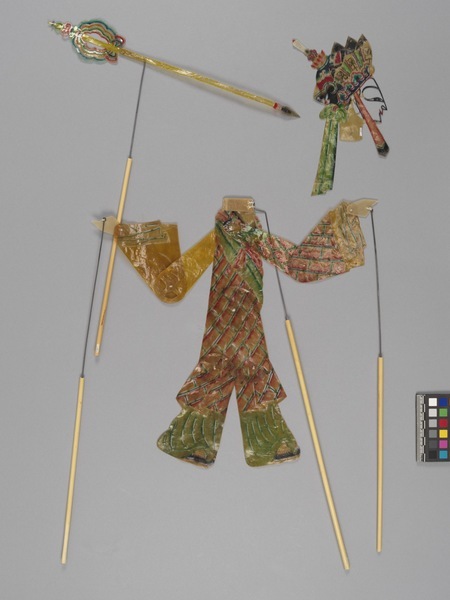Shadow Puppet Item Number: 3338/11 a-c from the MOA: University of British Columbia


Description
Tang Seng (Buddhist Monk from the Tang dynasty) shadow puppet with separate head (part b) and khakkhara or monk staff (part c). His face is cutout and outlined in black, and he wears a Buddhist crown on his head with large green ties. He wears a cloak and interior dress indicated by the different sleeves. The cloak and one sleeve have a red brick pattern with light green outline, and the other sleeve is solid yellow. He wears flowing green pants, which mostly cover his black shoes. Limbs jointed with fibre at the shoulders, elbows and hips. Operated by three rods. The khakkhara has a yellow shaft with a spear(?) tip at one end, and four repeating concentric designs (blue, red, green, red) and rings on the other end. Operated by one rod.
History Of Use
This piyingxi (shadow puppet) character, the Buddhist Monk, is from the classic Chinese narrative, “Journey to the West,” sometimes known as “Monkey King,” which is full of action, acrobatics, and martial arts. Puppets 3338/8-20 represent the four main characters (Pigsy, Monkey King, Sandman, Buddhist Monk), their horse, and the Eight Immortals, who are associated with the stylized clouds (3338/21-22), which indicate their identities as immortal beings.
Iconographic Meaning
The puppet is made in a classic north-eastern design (Luanzhou), from Luanzhouzhen in Heibei Province, one of the historically renowned regions of shadow puppetry in China.
Specific Techniques
The leather is scraped extremely thin which, together with their jointed limbs, makes these puppets highly flexible when they perform high kicks, jumps, and flips. When performing, their distinctive designs and vibrant colours are visible on the glowing screen, enhancing the magical effects of the characters in motion.
Item History
What
- Name
- Shadow Puppet
- Identification Number
- 3338/11 a-c
- Type of Item
- puppet
- Material
- cow skin, watercolour paint, lacquer, fibre, bamboo grass and steel metal
- Overall
- height 58.0 cm, width 10.0 cm, depth 1.0 cm
- Part C
- height 39.0 cm, width 32.5 cm, depth 1.0 cm
Who
- Culture
- Chinese
- Creator
- Lu Family (Maker)
- Previous Owner
- Lu Family
- Received from
- Lu Family (Seller) and Museum of Anthropology Exhibitions Budget (Funding source)
Where
- Holding Institution
- MOA: University of British Columbia
- Made in
- Tangshan, Hebei, China
When
- Creation Date
- during 2018
- Ownership Date
- before December 21, 2018
- Acquisition Date
- on December 21, 2018
Other
- Condition
- excellent
- Accession Number
- 3338/0011 a-c